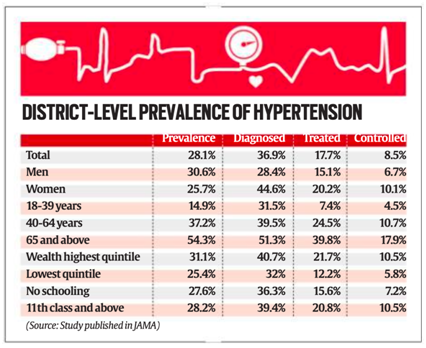India’s Hypertension Map
08-11-2023
09:20 AM
1 min read

What’s in Today’s Article?
- Why in the News?
- About Hypertension
- About the Study
- What needs to be done to Control Hypertension in India?

Why in the News?
- A new study finds significant variations in the occurrence and treatment of hypertension among Indian states, and also in districts within the states.
About Hypertension
- High blood pressure is a common condition that affects the body's arteries. It's also called hypertension.
- If you have high blood pressure, the force of the blood pushing against the artery walls is consistently too high. The heart has to work harder to pump blood.
- Blood pressure is measured in millimeters of mercury (mm Hg). In general, hypertension is a blood pressure reading of 130/80 millimeters of mercury (mm Hg) or higher.
- If untreated, high blood pressure increases the risk of heart attack, stroke and other serious health problems.
- Healthy lifestyle habits —such as not smoking, exercising and eating well — can help prevent and treat high blood pressure.
About the Study
- A group of researchers published an analysis of the recent National Family Health Survey data in the journal JAMA.
- As per the study, there is a significant variation in the level of prevalence, diagnosis, treatment, and control of hypertension among states and even districts within these states.
- The study found that a large proportion of those with hypertension do not get diagnosed, a large proportion of those who are diagnosed do not initiate treatment, and a large proportion of those who start treatment aren’t able to control their blood pressure.
- Only one in three receives a diagnosis, one in five gets treated, and one in twelve achieves blood pressure control.
- At state level:
- The study found that the prevalence of hypertension was similar among the southern states but higher than the national average — 29.9% of the population in the southern states as compared to 26.8% across India.
- The proportion of people diagnosed with hypertension in the southern states was similar to the rest of India.
- However, the proportion of people on treatment and with hypertension under control was higher in these states, the study showed.
- At district level:
- Not only at the state level, there were significant variations within districts, too. The researchers cited the example of two states to demonstrate this.
- In Meghalaya, the prevalence of hypertension was similar in the districts of Garo Hills (21.8%), Jaintia Hills (19.8%), and Khasi Hills (23.1%).
- However, the proportion of those diagnosed was lower in Garo Hills at 18.6% compared to 29.4% in Khasi Hills and 41.1% in Jaintia Hills.
- In Karnataka, four districts — Chikmagalur, Shimoga, Udupi, and Chitradurga — have a similar prevalence of hypertension, but the proportion of people treated and successfully controlled it was higher in Chikmagalur and Udupi.
- Role of Age, Gender & Education:
- Even at the national level, there were significant variations in the four levels of the continuum of care depending on the gender, age, socio-economic conditions, and education level of the person
- While it is well known that men are more likely to have hypertension as compared to women, surprisingly, the data showed that women were much more likely to be diagnosed, be on treatment, and have their blood pressure under control.
- The prevalence, diagnosis, treatment, and control were all higher among those over the age of 65 years as compared to youngsters.
- When it comes to socio-economic conditions, the prevalence, diagnosis, treatment, and control of hypertension was found to be highest among the wealthiest fifth of the population.
- While the prevalence of hypertension was similar among those who had no schooling and those who had passed class 11, diagnosis, treatment, and control were higher among those who had completed schooling.
- Significance of District-level Data:
- This district-level break-up of data can help state governments plan where and which level of care needs more resources.
- For example, in a district where medicines are not available at regular intervals, the proportion of treatment is likely to be poor.
- The local government then has to ensure that medicines are available regularly and at centers close to people’s homes.
What needs to be done to Control Hypertension in India?
- A recently released WHO report on hypertension said nearly 4.6 million deaths can be averted in India by 2040 if just half of the hypertensives were able to control their blood pressure.
- To tackle the issue, the government this year launched an ambitious initiative to put 75 million people with hypertension or diabetes on treatment by 2025.
- Further, a focus on active screening of people, putting them off treatment, ensuring the availability of medicine close to their homes, and ensuring follow-up will help in controlling hypertension in the country.
Q1) What is the difference between Heart Attack & Cardiac Arrest?
A heart attack is when one of the coronary arteries becomes blocked. The heart muscle is robbed of its vital blood supply and, if left untreated, will begin to die because it is not getting enough oxygen. A cardiac arrest is when a person's heart stops pumping blood around their body and they stop breathing normally.
Q2) What are Lifestyle Diseases?
Lifestyle diseases characterize those diseases whose occurrence is primarily based on daily habits of people and are a result of an inappropriate relationship of people with their environment.
Source: Hypertension: How its prevalence, diagnosis, control, and treatment varies across India | IE


